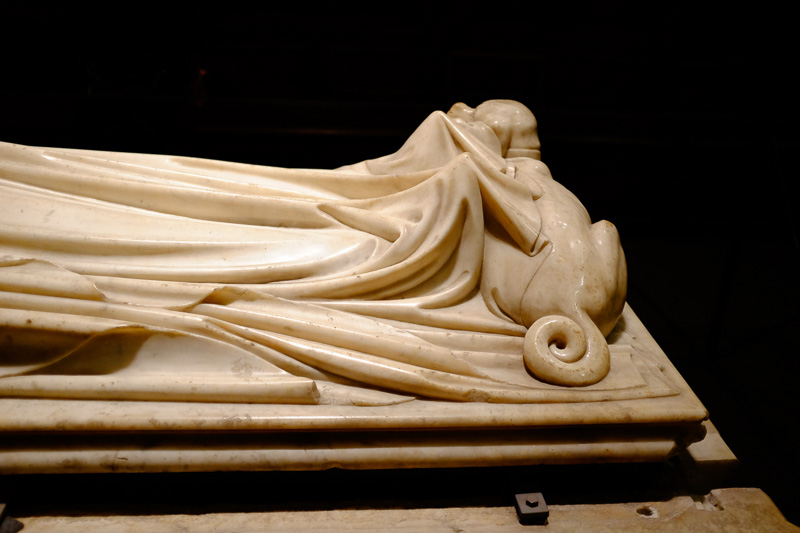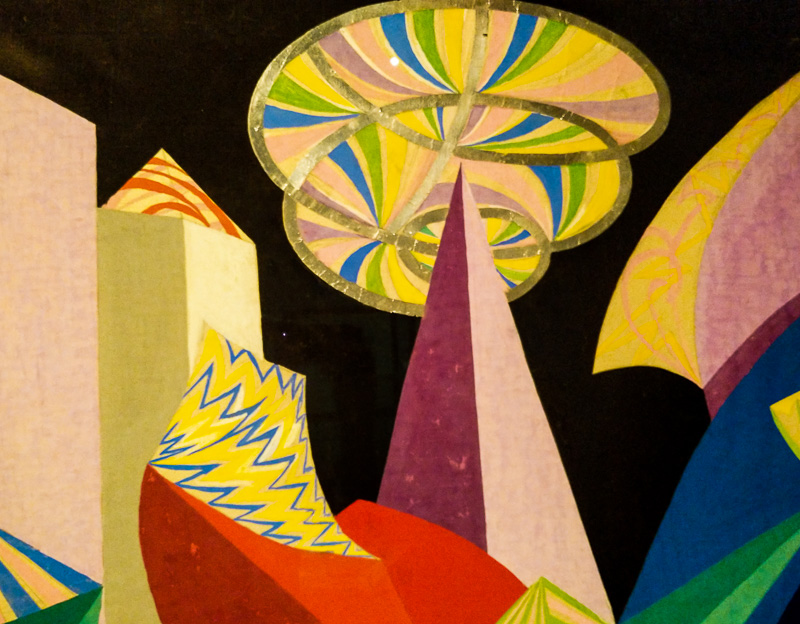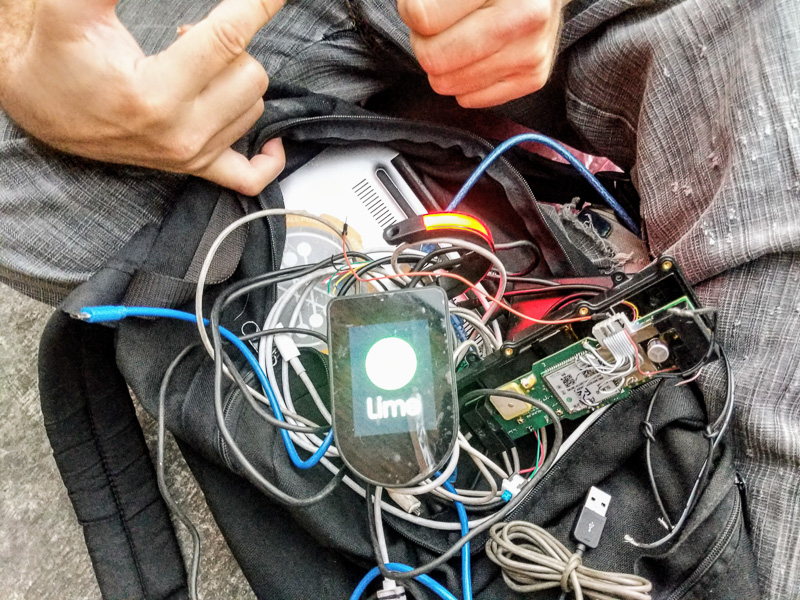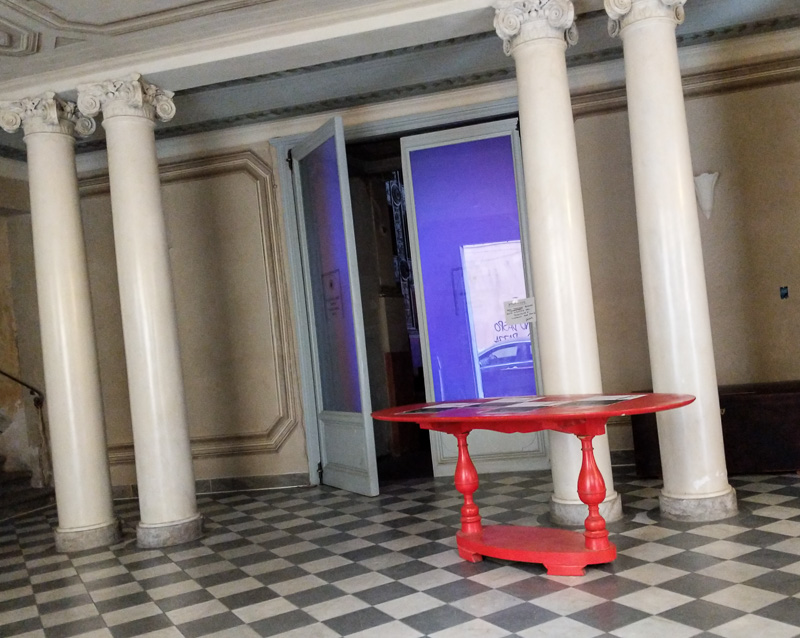This is a little intro talk I gave before a showing of The Matrix at the Pisa Internet Festival, October 11, 2019. I’ve illustrated this blog post with photos mostly taken in Lucca, a very nice town near Pisa. I’ll have 4 Italy posts in all. #1 is Pisa, this is #2 Lucca, #3 is Florence, and there’s a #4 of Genoa.

[Marble dog footrest for eternity. Love how smooth the stone is. Saw this in Lucca.]
Rudy to the audience in the theater about to see The Matrix:
It’s exciting to be in Pisa, the home of the 12th century mathematician Fibonacci, and of their 21st century Internet Festival.

[The Archangel Michael in Lucca. “He knows if you’ve been good or bad!”]
I’m a cyberpunk science fiction writer and a professor of computer science. In the 1990s I worked in a lab at Autodesk programming and designing early VR demos. Much of my novel The Hacker and the Ants is set in VR.

This morning I tried out the Apollo 11 virtual reality experience on display at the Pisa Internet Festival. I maneuvered myself so I was standing inside the hollow shell of Neil Armstrong’s body, guiding the Lunar Module towards a landing in the Sea of Tranquility.
It was viscerally engaging—we don’t actually require all that many cues to feel like something is real. But, as often happens with VR, it was a little lacking on details. The lunar surface was simply an unchanging 2D photo that got fuzzier as we approached it. Neil’s skin was smooth, like a mannequin’s. The dials on the control panel were static.
And by the end I had a bit of VR nausea, a condition induced by the mismatch between the fake and the real.

[They couldn’t cut and paste. so each time the the coat of arms was a little different. I like that.]
I’m here tonight to give a brief introduction to the classic VR move, The Matrix. I like the movie—it has good characters, and the CG effects are great. But I’ve always been a bit dissatisfied with the ideas underlying the movie. Maybe I’m just jealous that Hollywood still hasn’t filmed any of my twenty SF novels. But I do want to mention three of problems I have with The Matrix.

[The main “square” of Lucca is a big ellipse.]
(1) The movie’s premise is that there could be a computer-generated reality that’s indistinguishable from our own. For whatever reason, many people today believe this , and some go far as to propose that the seemingly real world around us is itself a simulation.

[Futurist painting of fireworks by, I think, Balla.]
Why would people want to think this? Perhaps it’s a Stockholm syndrome, and by this I mean a condition where prisoners of war begin to love and even worship their captors. Computers and the internet bully and parasitize us on every side. We’re obsessively addicted to our smart phones, with the social, the photos, the search, the music, the maps—tiny cornucopias, alluring sirens of the info sea. Hopeless and powerless in our cyberprison, we surrener and accept the computers as our lords—and go so far as to think the Supreme Being who creates our world is itself a digital program.

[I wish we had this beetle platter that we saw in Lucca.]
As a nature-lover and as a computer scientist, I know this idea is false. It’s phenomenologically clear that our reality is immensely richer than any possible simulation. You notice the deep fabric of reality whenever you take the trouble to leave your screens and go outdoors and observe, say, fluttering leaves, clouds in the sky, breaking waves, rain drops in puddles, people’s faces, the folds in clothing, the motions of crowds, the sounds of mingled voices in a piazza. Or pick up a dead stick in the garden, and peel off some bark, and observe the tiny creatures living there, and consider the fact that still tinier creature live within the guts of these mites. Look at the cracks in the wood, and the bits of fungus. God has a very big budget.

[This guy was celebrating with his friends outside a bar on a pedestrian street in Lucca. You can’t quite see in the photo, but he had a wooden cricifix strapped to his back. I asked him, “Are you getting married tomorrow?” His answer: “No! Today is my 33rd birthday.” And Jesus was 33 when he went on the cross.]
Another thing regarding the physical world is that natural processes don’t repeat themselves. You never step into the same river twice. The modern notion of chaos expresses this by saying that, although the world unfolds according to natural laws, physical processes are inherently unpredictable. This means there is no shortcut formula to predict what a wave will look like, or precisely how many times a quaking leaf will wobble in the next five minutes.

[In San Francisco, a young hacker friend of mine took apart a rental scooter so he could pwn it and use it for free. While disconnected, the scooter’s chip was screaming, “I can’t feel my wheels! I can’t feel my wheels!” ]
And understand that what I’m saying is not just an opinion—it’s a very nearly a theorem proved in theoretical computer science. I discussed this over a decade ago in my blog post, “Fundamental Limits to Virtual Reality.” The point, is that no cheesy, dipshit computer chip is going to crank out a precise emulation of our world. Not even if the cheesy, dipshit chip is the size of the solar system. Strict mathematical logic shows, in fact, that the only physical system that can emulate our universe is—our universe itself.

[Unbelievably gnarly mummified Saint in Michael’s Church in Lucca. He was called The Armenian.]
A lawn of grass blades is, if you will, a physical computer that emulates a lawn of grass blades. Using quantum computation, if you will, and running at the maximum possible speed, and with an octillion atoms in play. That’s what it takes.

[Talk about recycling! Spread over five centuries…]
Okay, okay, I don’t want to be a bring-down, I don’t want to harsh your vibe. But I said I have three bones to pick with The Matrix. Here’s the second and third…both are small points, but they bother me.
(2) Why would they be using human beings as, in effect, flashlight batteries to provide electricity? Like, how efficient is that? You’re keeping a guy alive, in a bidet in an underground stadium, you’re keeping him warm, and feeding him intravenously, and you think he’ll output more electricity than it takes to keep him alive? Please.

[Pisa concert hall. The part you can’t see is that an accordianist and violinist weres warming up inside, lovely tunes floating out.]
(3) In Matrix 2, they finally meet the chief programmer of the matrix and he’s—a fastidious, white-bearded guy in a cream-colored suit. Have you ever met any computer people? Like programmers and hackers? They wear T-shirts, they’re slobs, and they don’t speak with upper-class British accents.
They’re cyberpunks! Give us our due.

[Sylvia and I with Bruce Sterling and Jasmina Tesanovic at the Futurist art show in Pisa.]
But enough of all that. Enjoy The Matrix!
[After I delivered my intro, I stayed in the theater for awhile, and watched the start of the movie, dubbed into Italian, and it was really great, even better than I remembered, and it made me want to see the whole Matrix again. And never mind that it’s “wrong.” But then I left the theater to go to a club with Sylvia and Fabio and Roberto and Brolli and our other new Italian friends, and that was even better, even more cyberpunk. Nightlife with intellectuals at the Internet Festival in Pisa, Italy.]









November 23rd, 2019 at 4:48 pm
Perhaps, the AI runs in the plugged in brains, rather than the other way around.
November 23rd, 2019 at 5:14 pm
Rather than a simulation, suppose there’s a multi-layered quantum interpretation. That physics itself is evolving, but leaving a record as it goes. The interpreted thing is mathematics itself, or some subsets. The interpreter (magically) provides all of the colors, senses, emotions, and narrative primitives. The interpreter even provides a sense of Occam’s Razor to cover its own tracks 🙂